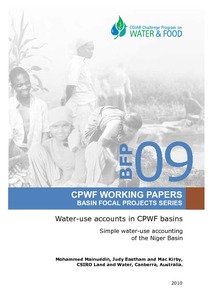Resource information
This paper applies the principles of water-use accounts, developed in the first of the
series, to the Niger River basin in West Africa. The Niger Basin covers 10 countries, and
rises in the highlands of southern Guinea near the border with Sierra Leone just 240
km inland from the Atlantic Ocean, but there are substantial downstream tributaries
from Cameroon and Nigeria. A unique feature is the inland delta which forms where its
gradient suddenly decreases.
Net runoff is about 12% of total precipitation. Grassland is the most extensive
vegetation, covering 50% of the Basin, consuming about 39% of the precipitation.
Rainfed agriculture covers 26% of the basin and use about 27% of the precipitation.
Irrigated agriculture covers less than 1% of the Basin and uses also less than 1% of the
water.
Climate change, using an assumed change in rainfall distribution, shows that climate
change may have a large impact on water availability in the lower Basin, and hence on
the River’s wetlands.


